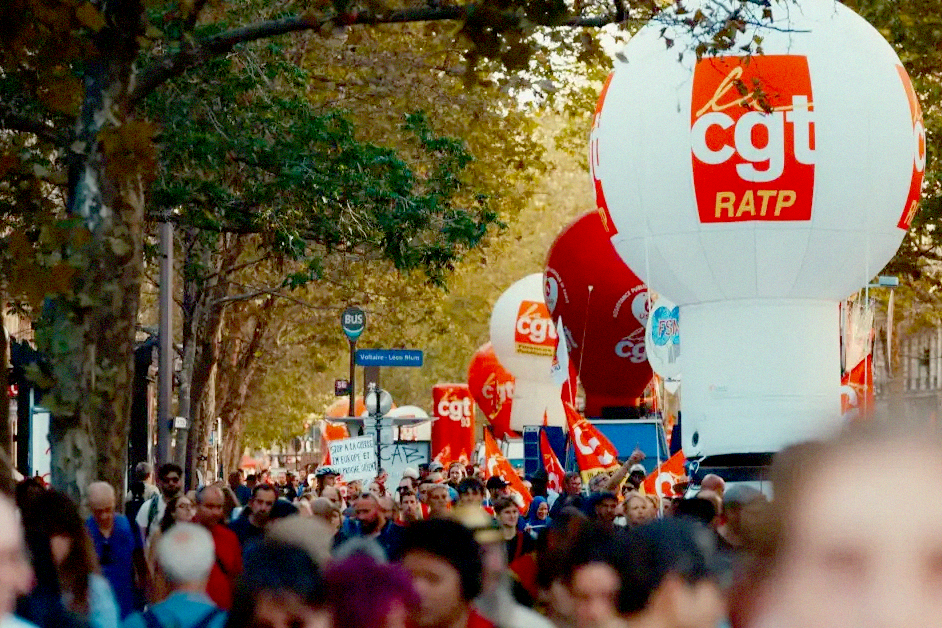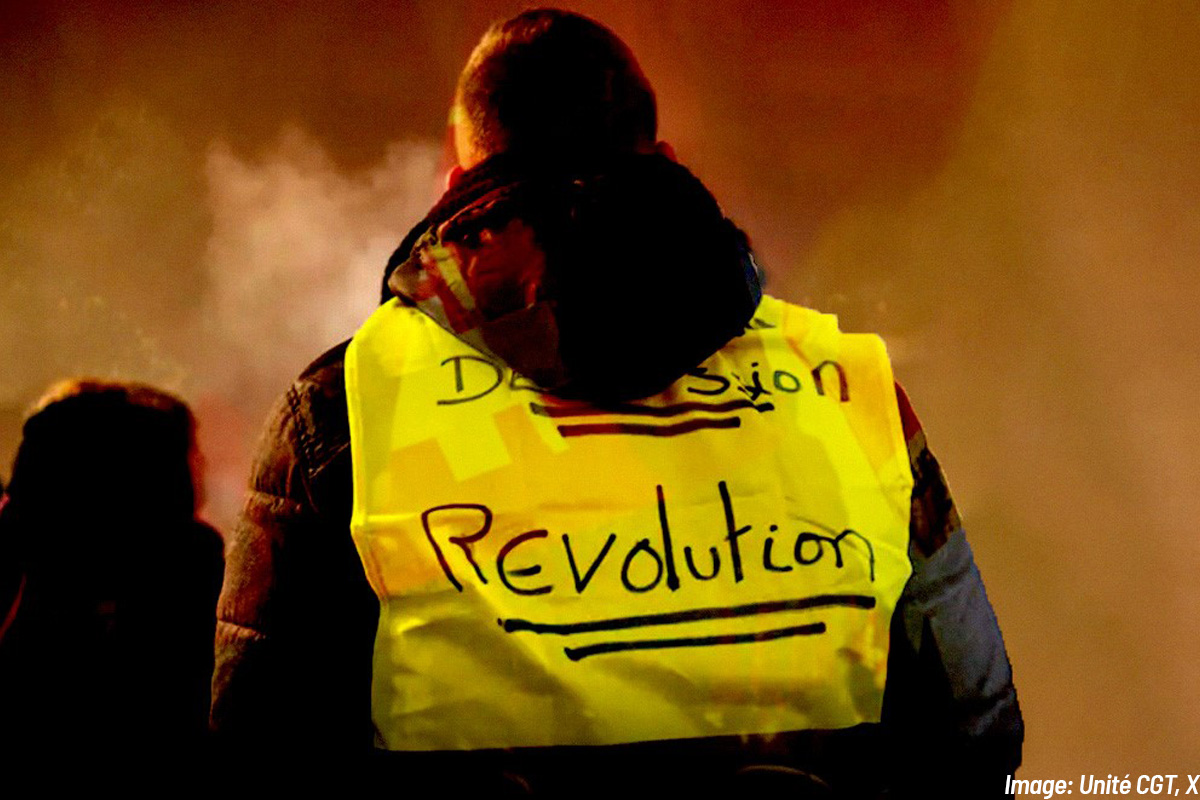The FIAT plant at Pomigliano d’Arco
(Naples) has become the centre of attention for all militant trade
unionists in Italy. The bosses are trying to implement new draconian
work conditions and in the process have used all kinds of bullying
methods. But they can push too far and the workers are reaching the
limit and preparing to fight back.
The 22 June ballot at the FIAT plant in Pomigliano d’Arco (Naples)
produced an excellent result for the workers, the left and class trade
unionism as a whole. Formally speaking it was a defeat, but this has to
be put into the context of what has been happening in the plant.
Marchionne, the managing director, wanted to see the opposition
completely crushed by a massive YES vote. But that didn’t happen, as
nearly 40% of the workers (about half the manual workers) said NO to
FIAT’s blackmail.
T-Shirts with labels
"Pomigliano will not give in" and "Resist"Everyone is
aware of the fact that the FIAT bosses could decide to withdraw their
investment plans for Pomigliano. The workers were well aware of this
also, which is why also among the 60% who voted YES a large number are
furious with the company. They voted YES out of fear and for tactical
reasons, thinking more or less along the following lines, “meanwhile
they’ll set up the production lines, then once the investment’s been
made we’ll see”. However, even this layer has never been convinced by
the bosses’ propaganda.
Marchionne was fully aware of this, which is why he included last
minute clauses that gave “guarantees” as to the so-called applicability
of the agreement. It is no surprise that he was not satisfied with
getting the signatures of the FIM, UILM, FISMIC and UGL unions, but also
wanted the surrender of the FIOM (the most militant of the engineering
unions), which he failed to get in spite of the enormous pressures that
were brought to bear on this union.
So the bosses staked everything on the ballot, aiming for a 90% YES
vote. They wanted to win by a knockout, thus annihilating the FIOM and
reducing the workers to slave conditions before bringing the Panda model
to Pomigliano. But it went badly for them.
The working class of Pomigliano resisted. On Saturday, June 19 there
was an attempt to organise a march of foremen and their families, but
this was a complete flop. It was a sordid attempt to repeat the infamous
1980 “march of the 40,000”. That was a closing chapter of the 5-week
long strike of the FIAT workers back in 1980. The bosses, to pile on the
pressure, had brought out foremen, middle management, technicians,
etc., in an attempt to portray a divided workforce with “masses”
demanding to go back to work. Even then, in reality there were no more
than 5,000 people marching through the streets of Turin, but the media
hyped it up to give a distorted picture.
The 1980 march, in spite of the relatively small numbers of
participants, marked a defeat opening up a 30-year long process of
retreat. Today, we are facing a completely different situation. The
Pomigliano struggle today could represent the beginning of a fight-back
ending that process and opening up a completely new one.
What is at stake
Rather than “modernity”, as claimed by the clown Sacconi (Minister of
Labour in the Berlusconi government) what they wanted was to turn the
clock back to the conditions faced by workers in the 1800s. But they got
their answer. It is not just a question of dignity, as many on the left
have stated. What we are witnessing at Pomigliano is something more, a
sharp shift in class consciousness.
The Pomigliano
workers feel the responsibility on their shoulders of representing the
interests of their class, of giving a reply to the Polish workers from
the Tichy FIAT plant (who recently wrote them a letter of sympathy which
circulated on the internet), saying that the workers of Pomigliano are
not indifferent to them, and are not insensitive to the fact that if the
FIAT bosses succeed at Pomigliano, from the very next day that
agreement will spread throughout the FIAT group and to all the factories
in the country, as is already being attempted at Indesit.
Then there is the question of exhaustion, which was already heavy
with the present work speeds and that would become even worse with the
proposed work study methods, which have even been condemned by the EU.
We would like to see gentlemen like Sacconi, or Veltroni and other
Democratic Party (PD) leaders who have been appealing to our “sense of
responsibility”, try working in these conditions.
For all these reasons the workers closed ranks around the FIOM, which
not only had to resist the pressure of the bosses and the logic of
global competition but also had to stand up to the pressures from the
CGIL leadership [the FIOM is part of the CGIL union confederation].
One of the worst aspects of the whole affair is not only the
declaration by CGIL General Secretary Epifani ‑ “I think the workers
will go and vote and will vote Yes” ‑ but the fact that even before the
meeting was held with the Pomigliano workers, the regional CGIL
secretary, Michele Gravano, and the Provincial secretary Peppe Errico
declared for a YES vote in the referendum.
The company was quick to photocopy their communiqué and distribute it
to all the workers to let them know that also the CGIL was inviting
them to vote for the agreement. The day after the ballot the Manifesto
published an interview with Michele Gravano accusing the FIOM of
“political infantilism” and arguing that the ballot was “an act of
democracy” which should be carefully assessed. Maybe what Gravano should
do is to carefully assess the “democratic” context in which the ballot
was held.
Bosses’ repressive measures
The ballot was managed by the company in military style. From
information that was leaked out by some “progressive” foremen, veritable
proscription lists were drawn up with the aim of isolating the most
“disruptive” shop stewards and workers.
An atmosphere of terror was organised in the factory, with threats of
individual reprisals. The workers received a DVD at home with the terms
of the agreement, together with threatening letters. During the ballot
itself maxi-screens in the factory broadcast the speeches of FIAT
management as to how beneficial the agreement would be. There were
phone-calls and text messages sent to the workers, and also the foremen
putting constant pressure on those going to vote, threatening the
closure of the factory should the NO vote win.
And yet in spite of everything 1,673 workers voted No! In spite of
the threats of the company, the hostile media campaign, the positions
adopted by the Democratic Party and the CGIL declaring themselves for a
YES vote, along with a sizeable part of the Italia dei Valori party –
Italy of Values ‑ a supposedly “clean”, ultra-democratic centre party,
and also with the spectre of losing their jobs, they still voted No.
On the side of the FIOM
Such an imposing No vote opens up a new scenario that must be
analysed in all its aspects and that puts the FIOM at the centre of
attention, as it could very soon find itself in a new dispute with the
company at a qualitatively higher level. The FIOM’s strategy up to now
has been not to influence the vote in the factory. It simply declared
the ballot illegal, advising the workers to go and vote in order to
avoid reprisals, but without giving a clear indication as to how to
vote. This makes the result of the referendum even more extraordinary.
Meeting of FIAT workers in
Pomigliano last yearNow Marchionne could open up a new
offensive, pressurising and blackmailing the FIOM leaders with the
threat of pulling out of Pomigliano altogether, which would oblige the
FIOM to radically change its own trade union activity and methods of
mobilisation, starting from the recent general strike of 25 June.
Certain hesitations should be avoided such as those that we witnessed
last year after the local strike of 27 February, which was an
extraordinary success. But it did take as long as 80 days of
demonstrations before the entire FIAT group was eventually called out.
Today the mobilization must be much better organized and above all it
must be effective. What also has to be taken into account is that the
mood among the FIAT workers is much more militant now.
The FIOM has been complaining for years ‑ and justifiably so ‑ about
the lack of political support from the official left and it is therefore
in a difficult position when it comes to launching this decisive
battle, against everything and everyone and without an official
political left capable of giving backing.
This means that a big responsibility has been placed on the shoulders
of the FIOM leaders. This may lead to some uncertainties and wavering,
which are understandable but it can in no way be justified. That is
because it is highly likely that things will now come to the crucial
stage.
The FIOM has opposed the agreement and this gives it an enormous
authority throughout the movement, but also some responsibilities. At
Pomigliano we are seeing a layer of new militants emerging who are
leaving the other unions who have adopted a position of compromise and
have been asking to join the FIOM. At Melfi, another FIAT plant, the
FIOM has regained the position of coming first in the shop stewards’
elections.
This is all positive, very positive, but at the same time it will
intensify the conflicts with the CGIL leadership and in particular will
alarm the bosses even more, who will attempt to put into practice their
counter-measures. It is not by chance that one of the leaders who
organized the demonstration in support of the company on Saturday, 19
June has declared on TV that they were concerned at the mood of
radicalization that they can see growing inside the factory.
Marchionne may decide in the coming period on a strategy of forcing
the FIOM out into the open. Even if he decides to maintain production at
Pomigliano ‑ which we are absolutely sure he will do ‑ he will still
not be satisfied with the outcome of the ballot. For him a 62% YES vote
is insufficient and he may try a bluff, calling on the FIOM to sign the
agreement in exchange for bringing production of the Panda to the
factory.
In such a scenario the FIOM cannot just limit itself to talking about
the illegitimacy of the ballot. It will have to organise mobilisations,
and bring the dispute to a higher level, with the aim of generalising
it. Needless to say, the CGIL leaders will not support it and therefore
problems of union “discipline” would also be posed. This would lead once
again an open conflict between the leadership of the CGIL confederation
and its most militant section, the metalworkers’ of the FIOM.
The debate within the left and the trade union movement
In this context, it is worth noting the position of the Democratic
Party [the party formed out of a fusion of the, ex-Communist, Democratic
Left and a number of smaller bourgeois parties]. It is sufficient to
report that a group of Democratic Party MPs recently sent a letter to
Zavoli (the president of the Parliamentary Control Commission over the
State TV) with the amazing allegation that “in this conflict, the media
have been giving too much coverage to the FIOM and not enough to the
other unions”. This is a clear indication that the leaders of the
Democratic Party fully back the conditions demanded by the FIAT bosses
and wish to isolate the FIOM.
The FIOM leaders are thus caught between a rock and a hard place,
i.e. they will either be accused of being responsible for pushing FIAT
out of Pomigliano if they adopt a militant stance or they will be forced
to sign an agreement which essentially destroys the national bargaining
system and the very right to strike, thus disappointing their own
ranks.
In a situation such as this, the only force which the FIOM can really
rely on comes from within the movement itself. It must make use of the
huge authority that the metalworkers’ union has built up throughout all
these years and that maybe it has used with too much caution in the
past.
The anger and the frustration which has been building up can be
organised. This can be transformed into a point of strength but only if
we do not look at the tops of the unions for points of support, but we
seek them out among the rank and file. We must seek to base ourselves on
the strength that comes from the movement itself, that strength that
will express itself if only someone offers it a channel.
Regarding this, we think that in the press conference given by
Maurizio Landini, the present general secretary of the FIOM, the day
after the ballot, he was too much on the defensive. He kept insisting
that the FIOM was ready to negotiate and that if the “unconstitutional”
parts in the agreement were removed, the union would be ready to accept
the big increases in productivity (read exploitation) included in the
rest of the agreement. By issuing such statements, the struggle against
the new 18-shift system, against the limitation of breaks, against the
methods of Earned Value Management (i.e. a method which is based on
making sure that every second of a worker’s labour is spent producing
value, of working almost like a robot, Editor’s note), is presented as
being secondary, while all the emphasis is placed on what is
unconstitutional.
It is clear that we support the FIOM leaders in the militant stance
they have adopted in the recent period. In the last few months in the
debate taking place inside the PRC we have supported the decisions of
the FIOM in coming out against the systematic attacks organised by that
wing of the party linked to “Lavoro e Società” [Labour and Society,
the former left wing current in the CGIL that has now moved very far to
the right]. It is one of the main reasons why we also came out against
the “Federazione della Sinistra” ‑ “Federation of the Left” ‑ project.
The “Federation of the Left” is an electoral front set up by the PRC
with the PDCI ‑ the Party of Italian Communists, a former right-wing
split off from the PRC ‑ and other small groups in the most recent
regional elections. The proposal now is to turn this into a new
political organisation. “Lavoro e Società” were one of the promoters of
this idea.
We are of the opinion that this alliance has tied the PRC to those
trade union leaders who are the least “dynamic” and the most
bureaucratized, and thus the party has alienated a lot of potential
support inside the FIOM and also within the “rank and file trade unions”
(like the Cobas).
The FIAT factory in
PomiglianoIf “Lavoro e società” does not break with
Epifani, the General Secretary of the CGIL (something that we know he is
not prepared to do), then Ferrero, the General Secretary of the PRC,
must break with this wing of the CGIL, both inside the party and within
the Federation of the Left. By doing so, the party would be able to
support a clear turn to the left and also support without any ambiguity
the struggle of the FIOM and of the left-wing current within the CGIL,
known as “La Cgil che vogliamo”. “La CGIL che vogliamo” – the kind of
CGIL we want – is the title of the opposition document presented at the
last congress of the union, and which has become the name of the left
wing inside the CGIL. This opposition current recently held its founding
conference on July 6, led by Gianni Rinaldini, the former, and very
popular, general secretary of the FIOM.
On the need to take such a step we have no doubt, and the comrades of
the FIAT Pomigliano PRC factory branch also share the same view. In
this struggle the comrades of the factory branch have played a
magnificent role. On our website we have published an appeal written
by the PRC branch and addressed to all the members of the party and to
the whole movement, to continue the struggle and to build around it
the solidarity of the whole labour movement.
The level of solidarity has been growing stronger in the last few
weeks. Action is being prepared in other plants of the FIAT group, from
the big Mirafiori plant in Turin to the plant in Melfi in the South,
from the Val di Sangro plant to the Ferrari factory in Modena. Hundreds
of solidarity resolutions have been voted by shop stewards’ committees
and by union assemblies in factories throughout Italy. Even the 14,000
fans of the “Pomigliano non si piega” [Pomigliano will not give in]
Facebook page are a clear sign of the mood of confidence of workers in
their own strength that it is building up around the Pomigliano dispute.
The comrades of the PRC branch at the Pomigliano FIAT plant have
played a key role in all of this and we can be proud of the work they
have done during the last two years in very difficult conditions,
putting forward a militant and alternative point of view inside the
factory, and building up support for such a position.
Militant mood at July 1st national meeting
At the July 1st FIOM national meeting, which brought all the shop
stewards of the FIAT factories together with the main factories of
southern Italy (800 workers were present in all), there was a militant
mood and a kind of “proud-to-be-FIOM” was on display. However, there was
no official proposal for concrete action apart from some sit-ins. The
struggle was postponed until September and there was no plan of action
drawn up by the leadership.
Matteo Parlati, a shop steward at the Ferrari plant, and Laura Serra,
shop steward at the Lasme plant in Melfi, called for a general strike
of all the metalworkers. Domenico Loffredo raised the need to take up
the struggle for all workers’ rights (starting with opposition to the
introduction of the 18-shift system) and to say no to any retreat on
this. Unfortunately, from the platform there was no answer to any of
these calls for concrete action.
The FIOM is now at a crossroads, and its leaders cannot count on the
FIAT bosses pulling the chestnuts out of the fire for them, especially
now that FIAT has just confirmed that the Panda model is going to be
assembled at Pomigliano. They will want to implement all the measures
included in the agreement, and although there was a big NO vote, they
will base themselves on the fact that the majority voted YES. Thus,
conditions in the Pomigliano FIAT plant are destined to get worse. This
means a big challenge is opening up.
The bosses are on the offensive. They have become accustomed to a
trade union leadership getting workers to accept rotten deals. But this
also means they can make mistakes and misread the real situation that
has developed among the workers. The shop steward from the Ferrari
plant, in fact, ironically thanked Marchionne because of the “many
mistakes he has made”. His aggressive approach helped make the
mobilisation the June 25 general strike a success. On the demonstrations
of June 25 there was a militant mood not seen for some years.
Now there are no excuses for holding back the struggle. The workers
have shown their willingness to fight. What is now required is to
harness this in the best manner possible. Any hesitation on the part of
the FIOM leaders would invite further aggression from the bosses and
could lead to a further worsening of conditions for the workers, for the
movement and for militant class trade unionism.
The workers of Pomigliano have indicated the road that must be taken.
Now what is required is that the labour movement as a whole goes down
that road, and stay on it until the bosses are defeated.





